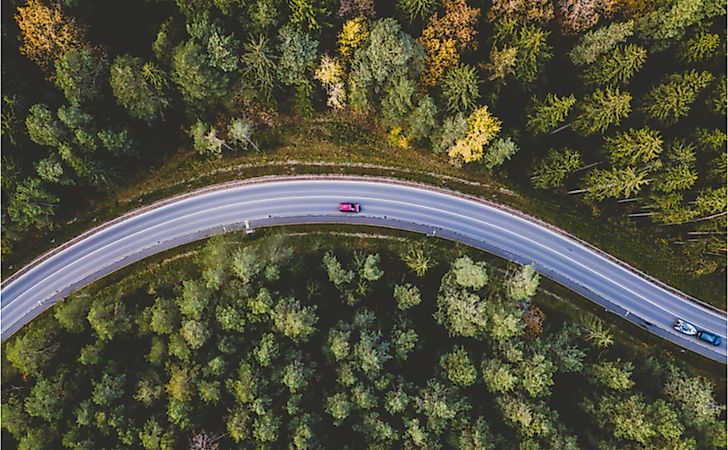What Are The Major Natural Resources Of Lithuania?

Lithuania is the most southern Baltic state in Europe with its borders being Latvia, Belarus, Kaliningrad Oblast, Sweden, and Poland. The country's capital and largest city is Vilnius. According to Eurostat, Lithuania's population was 2.848 million in 2017. Lithuania is the only nation in the world with a national perfume which is known as "The Scent of Lithuania." The country declared its independence in 1990. Currently, President Dalia Grybauskaite is the official leader of the Republic of Lithuania. During the 14th century, Lithuania was the largest nation in Europe. Historically, it was the last state to convert to Christianity among the European states. Lithuania’s nickname is “the land of stork” because stork is its national bird. There are over 13,000 pairs of storks in Lithuania.
The Natural Resources Of Lithuania
Forestry
One-third of Lithuania's land area is covered in forests, national parks, and protected areas. The fraction amounts to 2.1 million hectares of forest, a major natural resource for the country. About 33% of this forest area is owned by private citizens and over 60% is commercially owned. Economically, forestry is a significant contributor to Lithuania's GDP since it is a net exporter of wood and wood products. Specifically, 3.8% of the country’s GDP comes from the timber industry. In 2016, Lithuania exported $20 million worth of wood and its products to the USA. The largest forest in Lithuania is Dainava Forest which is 1350 square kilometers large. The 2nd, 3rd, and 4th largest forests are Labanoras Forest (911km2), Kazlu Ruda Forests (587km2), and Karsuva Forest (427km2) respectively. The average age of the trees in the Lithuanian forests is 53 years. Lithuania is situated in a mixed-forest belt with the most common tree species being Scots pine (42%), spruce (22.8%), and other species (35.2%) including birch.
Lakes And Fish
Lithuania possesses over 2,800 lakes and 816 rivers. Its largest river is the Nemanus River. The country has over 50 species of fish. Fishing takes various forms such as night fishing, sport fishing, and ice fishing. One of the popular places for sport fishing in Lithuania is Žveju Namai (Fishermen House). The restaurant is the only place where one can fish trout in large ponds. It also treats the fishermen to the trout that they fish. Sportfishing, also known as amateur fishing, also takes place in places such as the Klaipeda Channel and the Curonian Spit. Other fish caught are roach, salmon, pike-perch, zanthe, crayfish, turbot, bream, catfish, plaice, Baltic herring, Baltic cod, and perch. Ice fishing is quite popular in Lithuania during the winter season. Lithuania also has fishing museums such as the Mindunia which was started in 1988 by a history teacher known as Virginia Mackonienė.
Sportfishing in Lithuania is subject to several rules. One of those rules is that those who go fishing for fun must have an amateur fishing ticking. Besides, crayfish trap nets should not be more than 50 cm wide and 100 cm long. For single fishing, one can only catch a maximum of five fish. Besides, fishing using firearms, toxic substances, and electric energy is prohibited. Only specific underwater fishing guns are allowed. Thus, care needs to be taken in the course of recreational fishing so that one does not get into trouble with the law.
Mineral Resources
In 2014, mining contributed to 21% of Lithuania’s GDP. The country has large reserves of dolomite, clay, gypsum sand, quartz sand, and limestone. These minerals make a significant contribution to the construction industry by producing excellent quality of ceramics, cement, and glass. Other mineral resources are iron ore, phosphorites, sulfates, etc. Amber is a natural resource found at the Baltic Sea shores. Rivers such as the Neman River are capable of producing hydroelectricity.
Scarce energy resources such as few wells of oil located in the western part of Lithuania. Unexploited oil is said to exist at the Baltic Sea shelf as well as west Lithuania. Its exploitation could lead to oil worth satisfying 20% of the need for oil in the country. Besides, Lithuania has large portions of thermal energy at the coast of the Baltic Sea. However, mining of both thermal energy and oil is done through strip mining which is harmful to the environment. The exploitation of these resources also depends on the huge capital and intensive technology that Lithuania must outsource from foreign countries. Lack of these resources and the expected environmental pollution explains the hesitation of the government from venturing into extensive oil and thermal energy extraction.
Land And Agriculture
Lithuania’s land area is 65,300 km2. The land provides a home to many species of wildlife including wild boars, otters, wolves, deer, foxes, beavers, harbor elk, stags, ermine, and mink. Lithuania is also inhabited by hundreds of bird species such as white storks, swans, herons, ducks, cormorants, hawks, and the rare bald eagle. Besides wildlife, Lithuania’s land is also used for agriculture and forestry.
Agriculture is the 2nd largest sector in the economy of Lithuania. Between the 19th and 20th century, Lithuania was predominantly an agricultural economy. Currently, proportions of land used for agriculture are 35% for arable land, 12% for permanent crops, and 7% permanent pastures. Swam drainage and land reclamation efforts in Lithuania have resulted in land being made available for agriculture. Livestock breeding is the most popular form of agriculture in Lithuania. The farmers focus on the rearing of pigs and dairy cattle. Agricultural research institutions in Lithuania help in promoting agriculture within the country. Some of the institutions are Lithuanian University of Agriculture, Lithuanian Institute of Agriculture, and Lithuanian Veterinary Academy.
Thus, Lithuania is a rich country in terms of the acquisition of natural resources. Nonetheless, it is still on the verge of discovering and exploiting some resources like thermal energy and oil energy.
Learn about the world's 10 richest countries in terms of natural resources in this article here.











